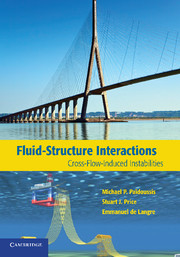3653 results in ebooks in fluid mechanics
5 - The volume-of-fluid method
-
- Book:
- Direct Numerical Simulations of Gas–Liquid Multiphase Flows
- Published online:
- 07 October 2011
- Print publication:
- 10 March 2011, pp 95-132
-
- Chapter
- Export citation
Appendix A - Interfaces: description and definitions
-
- Book:
- Direct Numerical Simulations of Gas–Liquid Multiphase Flows
- Published online:
- 07 October 2011
- Print publication:
- 10 March 2011, pp 270-278
-
- Chapter
- Export citation
4 - Advecting a fluid interface
-
- Book:
- Direct Numerical Simulations of Gas–Liquid Multiphase Flows
- Published online:
- 07 October 2011
- Print publication:
- 10 March 2011, pp 75-94
-
- Chapter
- Export citation
Contents
-
- Book:
- Direct Numerical Simulations of Gas–Liquid Multiphase Flows
- Published online:
- 07 October 2011
- Print publication:
- 10 March 2011, pp v-viii
-
- Chapter
- Export citation
9 - Atomization and breakup
-
- Book:
- Direct Numerical Simulations of Gas–Liquid Multiphase Flows
- Published online:
- 07 October 2011
- Print publication:
- 10 March 2011, pp 204-227
-
- Chapter
- Export citation
7 - Surface tension
-
- Book:
- Direct Numerical Simulations of Gas–Liquid Multiphase Flows
- Published online:
- 07 October 2011
- Print publication:
- 10 March 2011, pp 161-186
-
- Chapter
- Export citation
6 - Advecting marker points: front tracking
-
- Book:
- Direct Numerical Simulations of Gas–Liquid Multiphase Flows
- Published online:
- 07 October 2011
- Print publication:
- 10 March 2011, pp 133-160
-
- Chapter
- Export citation
Appendix D - The dynamics of liquid sheets: linearized theory
-
- Book:
- Direct Numerical Simulations of Gas–Liquid Multiphase Flows
- Published online:
- 07 October 2011
- Print publication:
- 10 March 2011, pp 288-294
-
- Chapter
- Export citation

Fluid-Structure Interactions
- Cross-Flow-Induced Instabilities
-
- Published online:
- 04 February 2011
- Print publication:
- 13 December 2010
20 - Theory of Distributions
-
- Book:
- Advanced Mathematics for Applications
- Published online:
- 05 June 2012
- Print publication:
- 06 January 2011, pp 568-619
-
- Chapter
- Export citation
Part I - Applications
-
- Book:
- Advanced Mathematics for Applications
- Published online:
- 05 June 2012
- Print publication:
- 06 January 2011, pp 51-52
-
- Chapter
- Export citation
List of tables
-
- Book:
- Advanced Mathematics for Applications
- Published online:
- 05 June 2012
- Print publication:
- 06 January 2011, pp xvii-xviii
-
- Chapter
- Export citation
1 - The Classical Field Equations
-
- Book:
- Advanced Mathematics for Applications
- Published online:
- 05 June 2012
- Print publication:
- 06 January 2011, pp 3-26
-
- Chapter
- Export citation
15 - Green's Functions: Ordinary Differential Equations
-
- Book:
- Advanced Mathematics for Applications
- Published online:
- 05 June 2012
- Print publication:
- 06 January 2011, pp 348-399
-
- Chapter
- Export citation
Contents
-
- Book:
- Advanced Mathematics for Applications
- Published online:
- 05 June 2012
- Print publication:
- 06 January 2011, pp vii-xii
-
- Chapter
- Export citation
7 - Spherical Systems
-
- Book:
- Advanced Mathematics for Applications
- Published online:
- 05 June 2012
- Print publication:
- 06 January 2011, pp 170-212
-
- Chapter
- Export citation
Part 0 - General Remarks and Basic Concepts
-
- Book:
- Advanced Mathematics for Applications
- Published online:
- 05 June 2012
- Print publication:
- 06 January 2011, pp 1-2
-
- Chapter
- Export citation
Part III - Some Advanced Tools
-
- Book:
- Advanced Mathematics for Applications
- Published online:
- 05 June 2012
- Print publication:
- 06 January 2011, pp 535-536
-
- Chapter
- Export citation
3 - Fourier Series: Applications
-
- Book:
- Advanced Mathematics for Applications
- Published online:
- 05 June 2012
- Print publication:
- 06 January 2011, pp 53-83
-
- Chapter
- Export citation
Part II - Essential Tools
-
- Book:
- Advanced Mathematics for Applications
- Published online:
- 05 June 2012
- Print publication:
- 06 January 2011, pp 213-214
-
- Chapter
- Export citation
